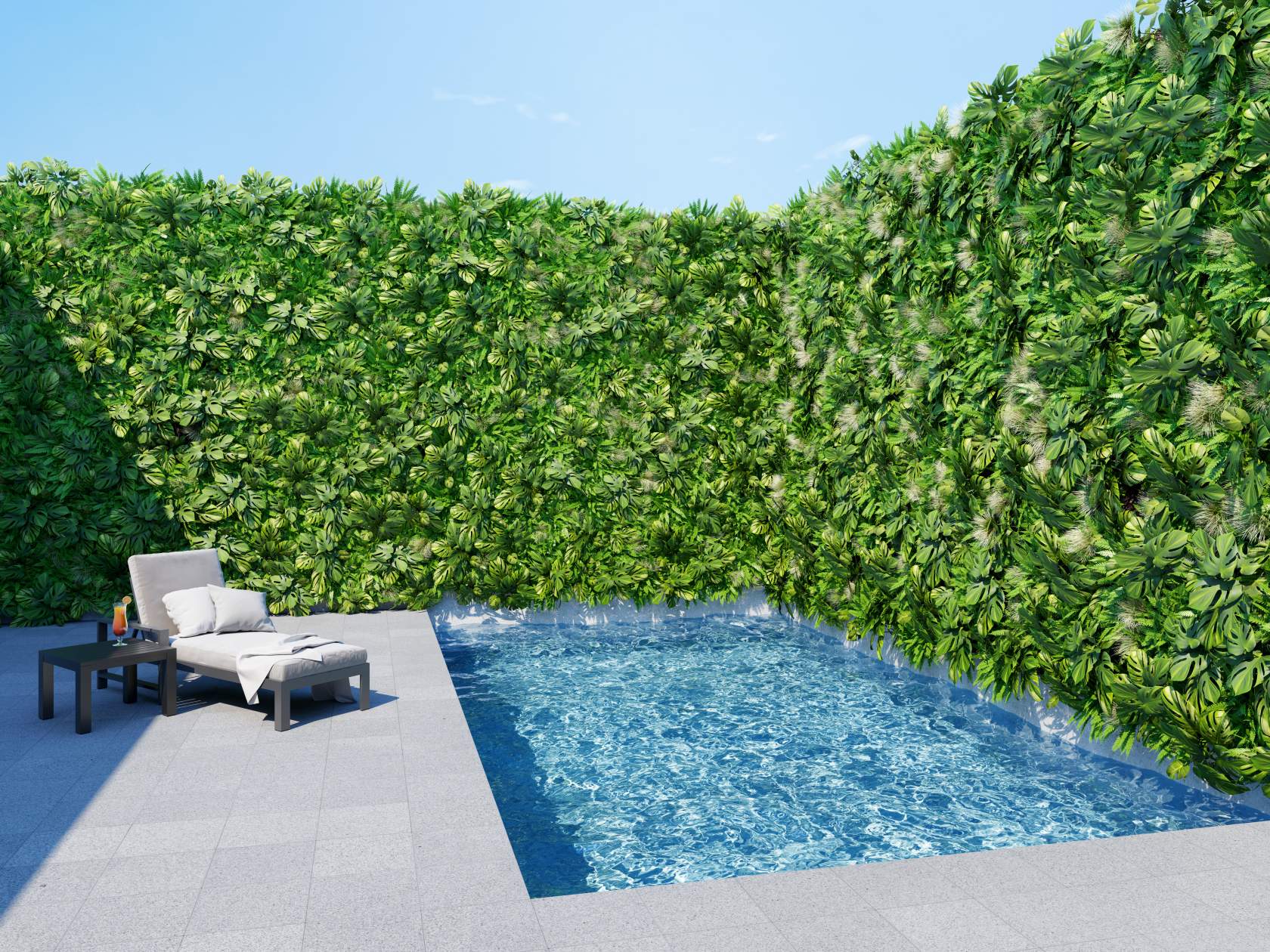

All grown up
The vertical garden revolution
Looking for ways to turn a dull outdoor space into a flourishing garden oasis? Relatively simple to install and maintain, vertical gardens and living walls really deliver the wow.
Nothing transforms a bare area like the addition of greenery – lush plants, cascading foliage and vibrant blooms can help bring a space to life. Vertical gardens have boomed in recent years, especially in urban environments, where they help soften hard surfaces and add a touch of drama without sacrificing space.
Greenery gains
There are plenty of reasons to install green walls or other vertically planted options – from appearance to privacy and even environmental considerations.
Appealing aesthetics
Transform your poolside paradise into a stunning green haven, amping up the atmosphere and creating a sense of resort style living at home.
With so many varieties of plants available, the world is your oyster – throw as much, or as little, into the design as you like. Colours, shapes and sizes can all be used to dramatic affect to create an area and ambiance that reflects your style.
Save on space
Growing up means you can enjoy a thriving garden without losing floor space, saving room for furniture, shading and other outdoor elements like fountains or firepits.
Protected privacy
A freestanding vertical garden can be used to divide areas, creating a natural screen that offers a sense of seclusion. Block out the neighbours and enjoy your pool in privacy with family and friends.
Purifying plants
There are even health benefits to installing green walls and pots, as some plant varieties filter pollutants and provide fresher air – a bonus if your garden is in an outdoor room or other smaller or semi-enclosed space.
Climate control
Thanks to the insulating properties of plants, a living wall cools hot outdoor spaces on long summer days and can help trap heat through the cooler months.
Sound investment
Replacing hard flat surfaces with plants will cut out reverberation and help reduce noise levels, bringing an air of tranquillity into your outdoor spaces.
A place to call home
Flowers, plants and grasses will attract pollinators like bees and butterflies, as well as other insects and birds that can help with pest management, creating an localised ecosystem and increasing your backyard biodiversity.
Getting started: how to build a vertical garden
Before you rush out to the garden centre, you’ll need to do some planning. Here are a few things to consider when designing for your space.
Location
You may have limited choices when it comes to location or have specific plants that you want to grow, but the site of your vertical garden or living wall will impact almost all other decisions…so choose wisely.
Unless you’re creating a self-standing wall, you will need to find a vertical surface – a wall or a fence – that receives enough sunlight to sustain the plants you want to feature. Be mindful of the changing conditions throughout the day and at various times of the year. A north-facing area that receives full sun in winter might struggle to support the same plants with less direct light in summer. Delicate plants may cope with a westerly aspect in winter but not survive a summer scorching.
Structure suitability
If using a wall or fence to support your vertical garden structure, make sure it can handle the load. The combined weight of the frame, pots, plants and wet soil can be substantial, so you’ll need to be sure that any fixings you use are up to the job and that the structure itself is sound. Seek some professional advice if you are unsure.
Planning
Determining the layout and design using plants is one of the most exciting parts of planning your vertical garden. Think about colours, textures and sizes – visualise how your plants will work with each other, as well as the other landscaping and design elements of your pool and outdoor area. It may help to sketch your ideas using online drawing tools or good old pencil and paper.
Plants need to be practical as well as being beautiful – don’t opt for anything with long spiky leaves if they are likely to stab passers-by and avoid plants that drop flowers, leaves, nuts or seeds if the wall is close to the pool.
Geographic location plays a part too, so look for native and climate-adapted plants that will thrive in your local conditions.
Preparing the frame
Garden centres and hardware stores have tonnes of ideas for vertical gardens and sell modular starter kits that make the whole job easy, with every aspect covered. Clip-together options let you mix and match individual pots, making it simple to rearrange the layout if needed. If you’re going the DIY route, trellises are a great starting point for a frame. Just make sure there is enough space between your frame and wall or fence to allow for air circulation.
Irrigation
This is where the wheels fall off for many vertical garden projects. Your vertical garden plants will need attention, including efficient watering. When you’re on the go juggling work, family and everything else, the last thing you’ll think about when you come home at night is tending to the garden. Setting up a drip irrigation or soaker hose means you can set and forget, knowing that your plants are getting the water they need with minimum waste and no fuss.
Planting
After planning and prepping, it’s time to purchase the plants and get them into the pots or frame pockets. Use the best quality potting mix you can find for the types of plants you’ve chosen. Garden centre staff can help with the right choice. Always follow the planting guidelines included and be sure you are leaving enough space for plants to fill out.
Ongoing care
All plants need regular ongoing care to live their best lives. Be sure to keep eye on the following:
Water – when it comes to water, most plants are like Goldilocks: they don’t like too little or too much. Even if you’ve set up an irrigation system, check the soil regularly and adjust water as needed. Some plants like to dry out between waterings, while others prefer constant conditions. They’ll behave differently throughout the year as well.
Fertiliser – plants need more than water and light to keep growing, especially in containers. They take the nutrients they need from soil, so you’ll need to keep it fed. If there’s a specialist fertiliser option available for your specific plants, use it. Otherwise, go for a general slow-release product and use as directed.
Pruning and trimming – remove leaves and flowers (also know as deadheading) and give plants a prune every now and then to encourage growth and improve air circulation, which helps reduce the risk of disease.
Pests – monitor regularly for any signs of pests like aphids or mealy bugs, as well as diseases like rusts and funguses. The sooner you spot any problems, the quicker you can act, minimising infestation to other plants.
Rearranging – you might notice some spots in your vertical garden promote growth more than others. Give all your plants a chance by rotating positions and seeing which location works best for each.
Gardening gives you a great reason to spend more time outdoors and there’s nothing more satisfying than watching your plants thrive. While these tips should help maintain your vertical garden year-round, don’t be afraid to experiment and make adjustments to see what works best.
